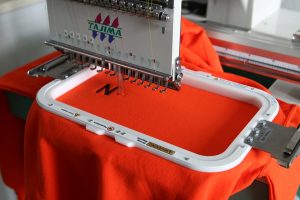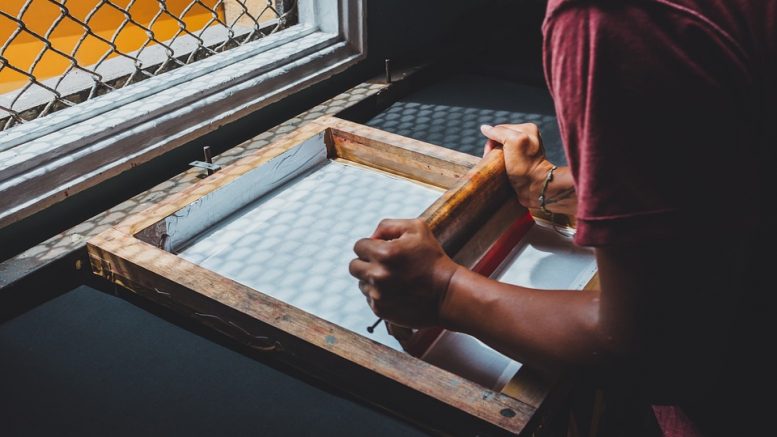While working with a Contract Manufacturing Partner, it is important to make sure that they have a way to brand your products. Branding your product is an important step in the development of a new product: not only is it free advertising when the product is worn out-and-about and the logo is visible, but it also creates brand recognition and is more likely to generate return customers. There are different methods that can be used to brand your fabric products, be it a carrying case, a wearable device, or anything else.
Embroidery is one of the oldest known methods of fabric decoration. This involves stitching the designs into the fabric and creating the design with the thread. Historically, embroidery was done by hand, and was seen as a status symbol for wealth and power. There are different styles of stitch that can create different looks, from broad colors to intricate details.

Embroidery Machine at work.
Today, most domestic, business-oriented embroidery is done via machine. Embroidery machines take an image and digitize it using special embroidery software, then allow you to choose different stitches, textures, and more to change the outcome of the finished product. The use of the machine as a branding tool is important, as it drastically reduces the margin of error from product to product. This also allows the embroiderer to work on other projects while one piece of fabric is being worked on, such as prepping the next piece or altering the image in the embroidery software, therefore reducing production time.
Screen printing is an ink-transferal process that does not involve thread, and produces the image on fabric using a piece of mesh stretched over a frame, ink, and a blade to distribute the ink evenly. Originating in Asia, screen printing took off in the early 1900s in Europe with the commodification of silk mesh, and with that the accessibility of the medium. It is technically a form of stenciling, which leaves behind a solid shape or design in ink. Only one color can be printed per screen, so in order to create a multicolor design, several screens must be used. Screen printing is ideal for complex logo designs that could involve shadows and gradients, as those can be easily screen printed with little extra effort.
Click here to learn more about our in-house Private Label and Branding Services.
So when do you use screen printing vs. embroidery?
When working with a Partner like us, we will often aid in the decision-making process of branding methods and location on the product. Embroidery can be limiting due to the size of (even the smallest) sewing processes and needles. Embroidery is slightly more expensive due to the price of thread and effort involved, but produces an extremely professional looking and durable design in the end which is perfect for corporate branding. Screen printing is great for complex designs, and can be slightly faster than embroidery. However, screen printing can be less durable, and can end up being just as expensive depending on the complexity or amount of different colors in the logo. The choice can also depend on situational factors such as the type of fabric, location on the product, and the resources on hand.
